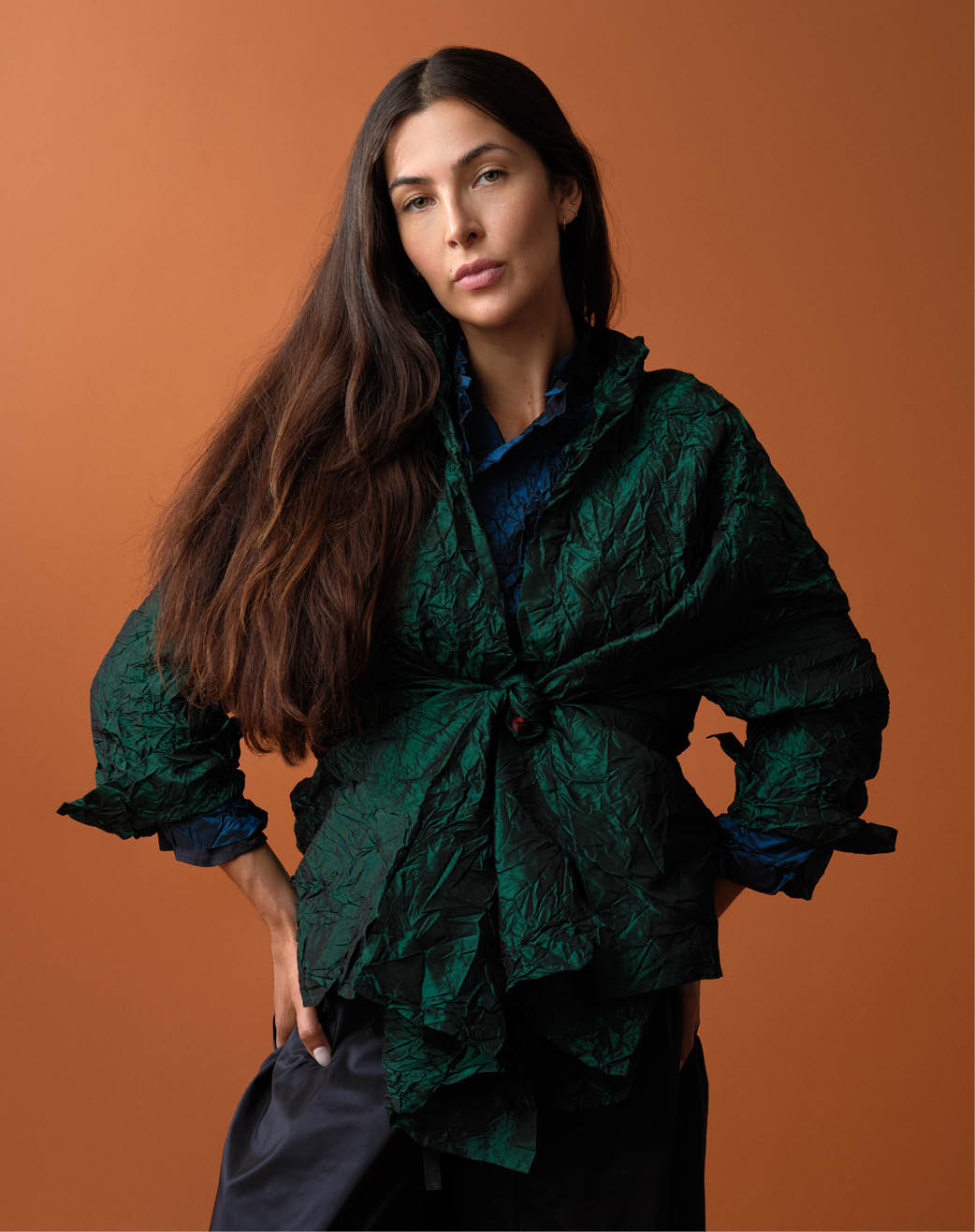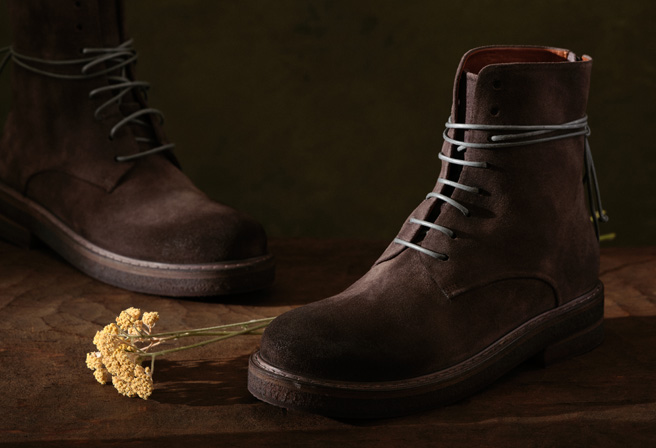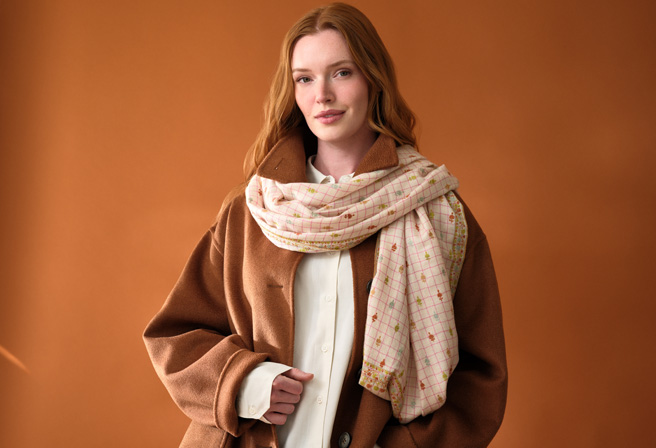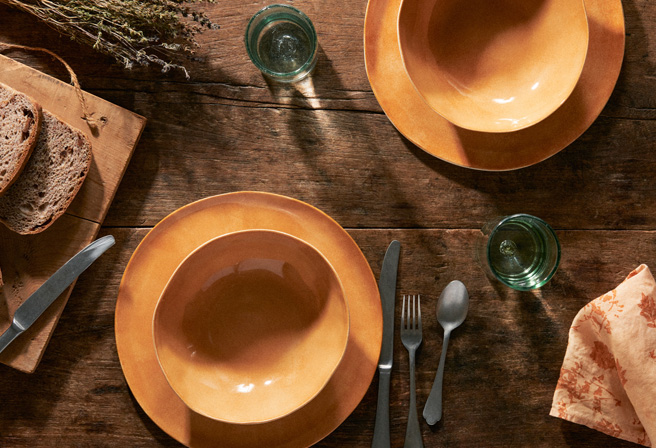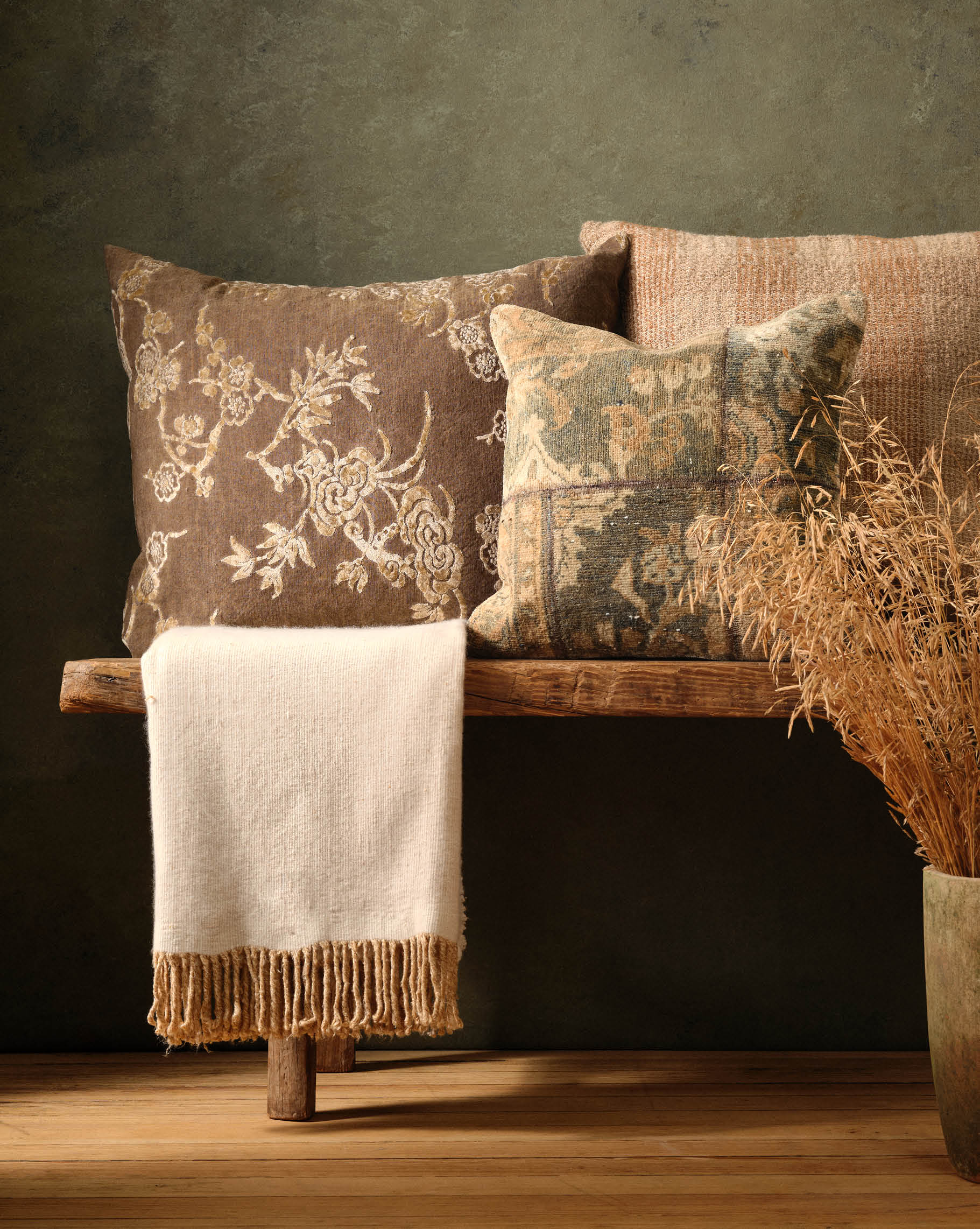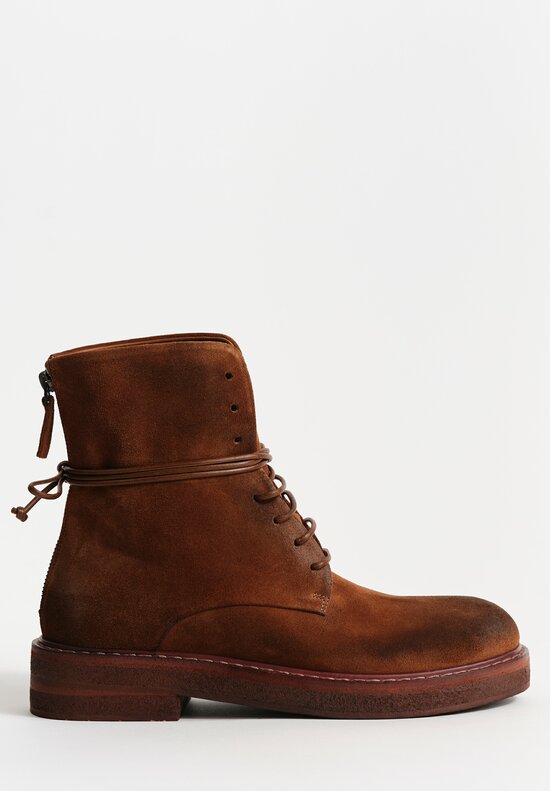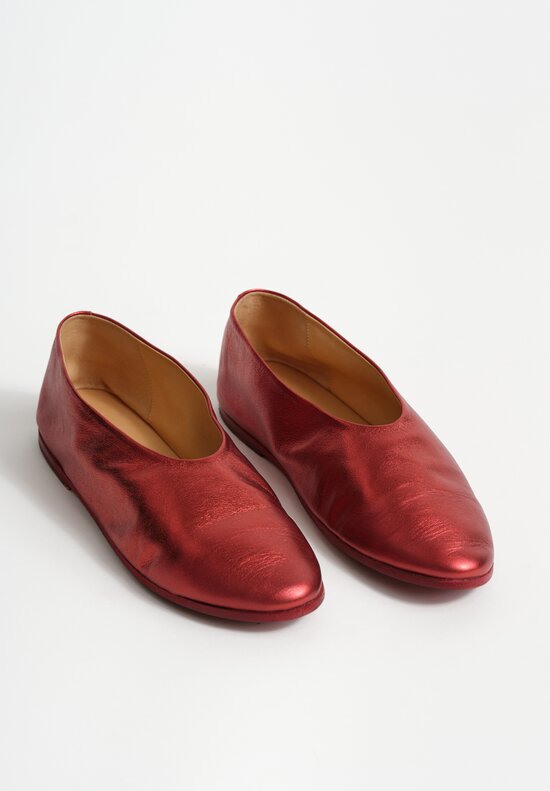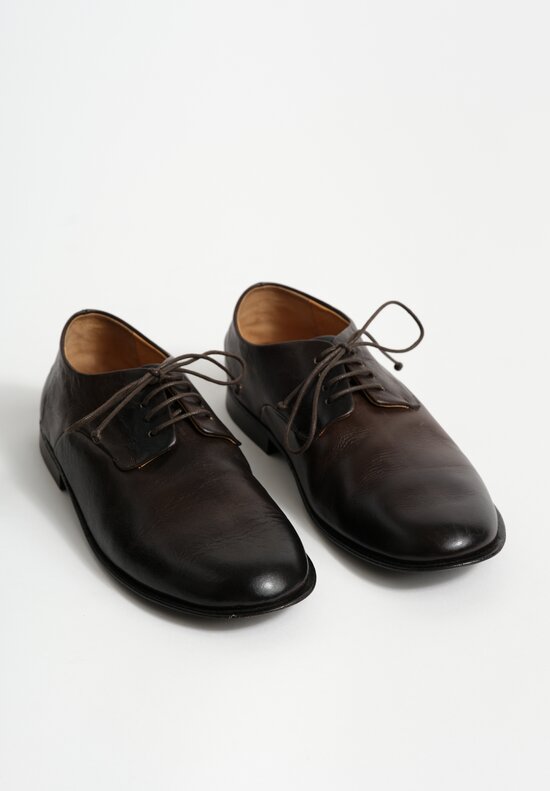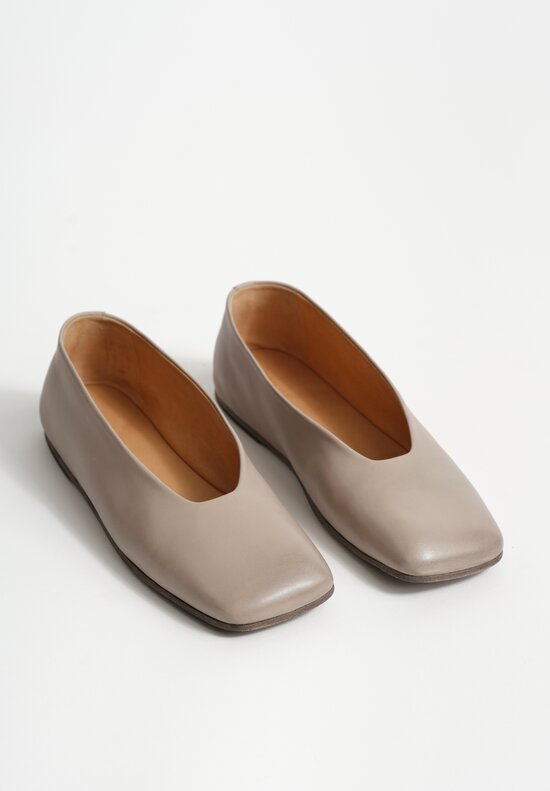Author Archive
Marsèll Presents: Persona
In honor of the brand’s 20th anniversary, Marsèll presents Eliot Sumner as the face of Persona, through a campaign shot by Federico Radaelli in Wiltshire, UK. Acting as a muse, Eliot is a multi-disciplinary artist the brand deeply identifies with, as they are the essence of natural beauty that pushes the boundaries of gender and labels.

Founded in 2001, Marsèll footwear uses an abundance of knowledge and the best raw materials. They defy boundaries of design using unconventional form, exaggerated soles and blunt shapes. Square toes are front and center in loafers and ballet flats where one would expect to find a soft, rounded edge. Similarly, the textured sole of their Sancrispa Derby contrasts with the refined silhouette of the polished leather body. Their expression in cut and texture thanks to their control over the production of their work has established their excellence worldwide. The forms and finishes of each piece are defined by the techniques implemented at the hand of expert craftsmen at the Marsèll workshop in the Riviera del Brenta Area, near Venice, Italy.


Knowledge, individuality and creativity are central pillars to Marsèll’s values. As such, they actively support young artists through their multi-disciplinary exhibition space — “Marsèlleria“. This non-profit project has produced exhibitions and performances that unite artists from multiple disciplines, blurring the lines between art, design, fashion and lifestyle.
It only makes sense, the persona representing Marsèll’s SS21 campaign would be Eliot Sumner. Eliot has many identities — Sting’s child, an actor, the former singer of I Blame Coco, an eponymous solo artist and most recently, Vaal.

As descendant of rock and roll royalty, it’s unsurprising that Eliot was interested in music at a young age, picking up a guitar at five. In their early teens, they felt the companionship a band had to offer. Later, signed at just 17, Eliot became the lead of I Blame Coco. By the time they were 21, Eliot decided to leave this sickly-sweet-pop-persona behind. They didn’t have a particularly bad experience with the group, it just didn’t feel true to who Eliot was. This change sparked the creation of two albums under their birth name, Eliot Sumner.

Most recently, Eliot anonymously created electronic music under the name Vaal. Their charismatic ability to take the crowd on a journey as a DJ is just one of their strengths. The reason behind keeping their identity a secret for three years is simple — they wanted their talents to lead a room to take precedence over their history.
Growing up, Sumner never explicitly came out to their parents. Even now, it’s not a topic they discuss at length with publications. Make no mistake, this isn’t due to a sense of shame. It’s just an aspect of Sumner’s identity that they believe isn’t surprising, as they’ve always been open and easygoing about who they are, in all of it’s fluidity and androgyny. When asked about pronouns, they respond simply, “call me how you call me.”

“ I didn’t come out as gay, I came out as I don’t really believe in gender.”
– Eliot Sumner

This collaboration is a perfect example of Marsèll’s values, as they maintain a belief that shoes are a personal choice, extending beyond fashion and lifestyle, speaking to the person you present to the world every day. They want their work to be worn in a way that expresses who you are individually, unlimited by labels or boundaries.
Form & Forest
 |
|||||
 |
|||||
|
|||||
 |
|||||
|
|||||
 |
|||||
 |
|||||
|
|||||
|
|||||
 |
|||||
|
|||||
 |
|||||
 |
|||||
|
|||||
|
|||||
 |
|||||
|
|||||



| Copyright © 2021 Porter Associates, Inc. All rights reserved. 53 Old Santa Fe Trail (On the Plaza), Santa Fe, NM 87501 (505) 982-61920 If you’d prefer to not receive any emails, unsubscribe here |
Su Casa: Winter 2021
A selection of home goods from Wild Life was recently featured in the Winter 2021 issue of Su Casa Magazine. The “Preservation with Personality” article highlighted a Sempre outdoor umbrella, pillows from The Good Shepherd, and a selection of Vintage Moroccan pillows and textiles.



House Beautiful: Best Home Stores in America
House Beautiful’s list of Best Home Stores in America was formed in the spirit of America’s small business owners, designers and artisanal merchants. We are proud to be featured in their December issue as the Best Glassware Store in America. Material tactility is at the center of how we curate our glassware. Our designers possess their own unique understanding of hand-touched simplicity. Their soulful impressions originate across the globe and come together around our Wild Life table, imbued with glimmer and cheer.

Representing the delicate and meticulous hand within our collection is Michael Ruh, Canvas Home and Astier De Villatte. Michael Ruh’s harmonious blend of contour and assertive lines is formed by a process of incising into the near-finished shape when hot. His pieces are handblown in London, each engraved with his signature at its base. Canvas Home believes a blank canvas is something full of possibilities and useful in purpose. They celebrate the beauty of natural materials that are crafted into simple, one-of-a-kind shapes and silhouettes. Astier De Villatte follows in the tradition of the great 18th and 19th century Parisian ceramic studios. Working from an antique Bastille workshop, historically home to Napoleon Bonaparte’s own silversmith, Astier De Villatte’s designs are concocted with the adventurous whim of a visit to the Vanves flea market and the opulent curiosities of Neoclassicism.

La Maison Dar Dar, Sempre, Xaquixe, and La Soufflerie form handblown glass for the highly spirited. La Maison Dar Dar is so vivid in color, the vessels evoke hand-dyed silk. These hand blown glasses are imported from France and sourced from Syria. The handwork is notably emphasized in their champagne flute, a playful shaping of an iconic form. Belgian-based Sempre creates natural, sturdy glasses congenial in essence. Studio Xaquixe focuses on sustainable and ethical production practices, including recycled material and alternative energy sources. La Soufflerie is a family run company reviving, supporting and encouraging the ancestral art of glassblowing. Their wares are timeless, durable, and are meant for everyday.
Wild Life was established to bring nature and culture to the forefront of home. Aimed at connecting people, our glassware does just this — to bring all around the table.
Sabina Savage: The Treasures of Pompeii Drawings
View the collection illustrations in progress, and see how the drawings transform into detailed and intricate scarf designs.
Sabina creates a story for each collection, as shown below, which is then illustrated and narrated through her elaborate handiwork.

As catastrophe looms over the ancient city, which possessions will be valuable enough to save?
The year is AD 79, and as Mount Vesuvius begins to erupt, it sends a plume of ashes, pumice and rock into the sky causing the Pompeiians to flee in their droves. There is time to gather only a small handful of belongings and supplies; the residents must board the waiting ships and evacuate the city at once or become shrouded in the thick ash which rains from the skies. This pyroclastic cloud will soon swallow everything in its path; houses, market stalls, streets and amphitheaters are to be blanketed in molten rock. In their haste to escape the threat of certain doom, many citizens leave their animals behind to face the desperate situation alone, and the most careless among them leave their companions caged or chained with no hope of release. Thankfully, the animals in this story are wise enough to help themselves.

As the last overcrowded ship departs the shore, a small, ornate box of valuables slips from deck unnoticed, spilling its precious contents into the water. Coins, rings and amulets sink into the briny depths, entangling the sea creatures below and preventing their release from the increasingly warm shallows. The ducks spot this misfortune and swiftly dive in to assist their aquatic peers, untangling chains and releasing clasps until the captives are freed. The fish are grateful and offer up the coins as payment.

In the town centre, the first scorching ash begins to settle on an old greyhound’s back. He is chained to the doorway of his master’s villa, a large ornate padlock fixing him to the wall. He bites at the chain and tugs with all his might, but the metal is too strong, and he is becoming weak in the heat. As the dog begins to despair, a great heron flies from the waterside and comes to land gently beside him. In her beak she holds a glistening metal key, rescued from the fallen box by the flock of kindly ducks. The heron deftly fits the key to the lock and the greyhound is released. To show gratitude to his avian friends, he bounds into the house at once and fetches the master’s helpless caged birds, before setting off to the shoreline to find their escape.

Back at the water’s edge, several smaller wild animals are also seeking freedom from the imposing ash cloud overhead. As they pace the shallows fretfully, the ornate mosaic box fallen from the ship washes up at their feet. Now empty of its riches, save for a few gold coins, it is the perfect raft to safety. The animals fill the box with fruits and nuts for their long journey ahead, before climbing inside and closing the lid; this box now holds a far more precious cargo. With one gentle push from the greyhound, they glide out into the ocean and pray for salvation.





Sabina Savage: The Treasures of Pompeii Moodboard
The studio moodboard for The Treasures of Pompeii has a palette of antiqued, ancient hues taken from the walls of the historic city. Discover key elements of Sabina Savage’s research here, and view some of the images which inspired her designs.


This collection references the beautiful artworks and artifacts uncovered during the excavation of the Italian city of Pompeii, and most especially, the preserved remains of a helpless chained guard dog. Mount Vesuvius erupted in AD 79, covering the city in volcanic ash and preserving a unique snapshot of Roman life.
From the intricate stone mosaics and hand-painted frescoes to the ancient molded coins and figurative jewellery, the beauty and symbolism of the Roman arts are astounding. While ruthless and barbaric in a number of ways, their creativity holds a delicacy and complexity which is rarely found in the modern world. The exquisite Roman Lod Mosaic uncovered in Israel is also referenced in this collection, alongside the architecture and artworks of ancient Rome and the written accounts of Pliny the Younger.


About Rianna + Nina
Rianna Nektaria Kounou and Nina Knaudt met by chance at a vintage furniture fair. For twenty years Rianna had been the face of high quality and rare vintage pieces in Greece, collaborating with magazines and celebrities and consistently surprising clients with an amazingly detailed knowledge of fashion through the decades.

She had spearheaded two wildly successful vintage storefronts, “Berlin” in Athens and “Rianna in Berlin” in Berlin. Meanwhile, Nina had been nurturing her dreams of working in the fashion industry through working in PR and studying Fashion and Design Management in Milan. Their meeting was instantaneously vibrant and they quickly realized how many of their passions overlapped.

In 2014 the duo opened their first shop together: “Cabinet de Curiosities- RIANNA + NINA” in Berlin Mitte. It was the beginning of a colorful journey that has since grown larger than the pair had ever dreamed. To this day Rianna’s designs for their eponymous label, RIANNA + NINA, are influenced by her family and cultural background. Originally from Athens, Greece, she was raised by parents with a deep understanding of fine fabrics in the most creative and colorful means. Nina’s similar value for color and classical training in fashion and marketing has been invaluable in injecting their vintage flavor with an extra dose of intellectualism. Together their one-of-a-kind pieces transcend time and style.

Our connection to RIANNA + NINA has been as colorful as their clothing. We spotted Nina on the streets of Paris looking absolutely incredible… while pushing a baby stroller.
We followed after her and climbed the stairs of their showroom only to be greeted with the warmest of Greek embraces from Rianna. Within five minutes we were competing with Vogue France to buy their collection of six kimonos; the official vintage offering for the season. We jumped at the chance to claim them for Santa Fe Dry Goods.

Their clothes speak of a dream uninhibited and are full of laughter and joy. Is it any wonder Rianna and Nina find themselves the darlings of WWD, Vogue and Harper’s Bazaar? We have found them welcoming, open-minded, eclectic, and the loveliest of creators to represent.
INSIDE | OUT: Album di Famiglia
An interview with Monica Rusconi of Album di Famiglia regarding life, love and the significance of family in her designs.

You have dedicated your Spring collection to your mother and her love for the moon. Can you tell us more about that love? How has your mother influenced this collection?
It is a winter evening. And I’m returning from work. My son Pietro, six months old, is at home with my mother. When I arrive, they’re not there. I search all over the house, but I can’t find them. So I go out. The Moon is high in the sky. It is a giant white balloon. And they are there: my mother with my son in her arms, wrapped in a scarf. “We wanted to see the moon,” said my mother.
It is always evening. But this time it’s spring. I’m going to the hospital to see my mother. There is silence in the bedroom. She looks out of the large window. “Look what a beautiful moon!” she says. This is the last sentence I remember from her.
When it is evening, I often look at the Moon. And it is as if she was looking at me too. The Moon, my mother…
What is the significance to the repeated circular pattern featured in this collection?
Kinya Shimizu, Japanese artist and dear friend, represented the Moon for us with different techniques. They are the [featured] circles of the latest collection: full moon, black, waning, crescent. The moon is circular and the circle is a very important figure for me. My life is a continuous search in an attempt to connect all the things I love. Just like a big circle.
Your clothing’s identity is heavily centered around your family- it is even in the name! What is the importance of family in your work?
Family and work are closely linked in my life. They are my life! But I also think that clothes develop a strong family identity.
I am the second of four brothers. And my mother has always taught us to love our clothes, our toys, our books. A dress is not simply a dress. It’s something to take care of. It is something that is handed down from brother to brother, from sister to sister. It is something that lasts over time. This is how a dress creates a passage, a ritual, a bond.
Do you design for any specific person in mind?
When I design my clothes, I design shapes and volumes that I would like to wear myself. But my main goal is always to valorize, and therefore, I try to create clothing that feels good for anyone who wears them.

Cotton and Linen are the primary materials you use for creating your clothing. What do you like about working with those fabrics?
Your woven cottons have a very particular papery feel. Can you tell us more about the cotton and how it is woven? Why is this important to you?
Your knitwear also has a specific feel on the skin. How would you describe this and what is your goal with this part of the collection?
I fall in love with fabrics! But when I have to make a choice, the fundamental consideration is always the comfort they must ensure. For the summer, my favorite fabric is a very light canvas with a paper “crunchy” [feel], which allows me to create interesting volumes and shapes. This canvas is made with a thin thread of high-quality American cotton, so many threads have to be used to weave it.
The main fabric of the winter is a recycled material, obtained from [reclaimed] fabrics, which are processed again to get a new regenerated yarn. We have been using this fabric since the beginning, and we have never abandoned it. Above all, I love its sustainability, the softness, warmth, and comfort it guarantees to our garments—a real hug in the cold days of winter.
Your designs often have an understated complexity. What do you find is the most important aspect of the design process?
When I design a new collection, I usually start from a word, from a concept that I want to express at that moment. For me, a dress is not just a dress. It is a message, a thought, a philosophy. Our philosophy. I think Fashion should not be simply the production of clothes, but the creation of culture. So, from a few seasons, I’m also showing the collection through books and performances, with the aim of best conveying the philosophy and culture of Album di Famiglia.
What are some of your favorite shapes or items in the collection?
There are no forms that I prefer and seek more than others. I love geometry itself. Its cleanliness, simplicity, and rigorousness. This is why I like to call myself a designer rather than a stylist: in fact, I study my garments as if they were design objects, where aesthetics and functionality meet.


Our thoughts have been with you and all our designers in Italy for the past several months. What has it been like to live and work there during this time?
I am an introverted person. So, I haven’t suffered from these months of lockdown. The most difficult thing was to work, knowing that there was a lot of suffering, fear, and uncertainty in the world. To the sadness, I reacted by looking for new solutions and new ideas to continue doing what I love, aware that clothes are not a primary necessity, but also aware that Album di Famiglia gives work to many people every day. And work is a fundamental necessity.
What will change in the design of clothing in the world as it is now?
What is your dream for design in the future?
I think recent events offer us a real opportunity to query ourselves, to see our errors, to change, to evolve. I dream for pure and essential design, and recovering the rhythm of the seasons.
In my search for simple, sober, and qualitative clothing, I will put a more significant commitment to ethical and sustainable projects. Even if we never throw anything away and, we always try to enhance the value of what we have. Examples are the “Simply, clothes” of our e-shop and the new [Up]cycled collection project, that we are showing soon!
What would you like others to know about Album di Famiglia?
This year ADF turns 20 … but the ADF story begins a long time ago, from my dolls’ clothes, which I still keep and one day I would like to show you!
Why do you think the collection is so successful for Workshop clients who live and visit Santa Fe?
I like to think that Workshop clients are people who share our philosophy and values, despite the geographical distance that separates Italy and New Mexico. People who appreciate the simplicity, quality, and comfort of our shapes and materials. Free-thinking people, who shy away from fashion homologa
Boro
Lorem ipsum dolor sit amet, consectetur adipiscing elit, sed do eiusmod tempor incididunt ut labore et dolore magna aliqua. Ut enim ad minim veniam, quis nostrud exercitation ullamco laboris nisi ut aliquip ex ea commodo consequat. Duis aute irure dolor in reprehenderit in voluptate velit esse cillum dolore eu fugiat nulla pariatur. Excepteur sint occaecat cupidatat non proident, sunt in culpa qui officia deserunt mollit anim id est laborum.
Horisaki: Controlled Burn
Horisaki Design & Handel create handmade pieces ranging from wide brim fedoras to stylized caps… often subjected to their signature controlled burn.
Founded by husband and wife, Makoto and Karin Horisaki, the company is tucked deep in the forests of Sweden. Their Småland workshop is dedicated to carrying on traditional millinery techniques in the way they craft headwear. One of their most surprising techniques is the burning of their hats.
Using a blowtorch they set fire to the hat, being careful to not let the piece burn too long. The controlled burn creates a slightly distressed finish that is unique to each piece. Although daring, the end result is delicate and thoughtful. After beginning to experiment with this process six years ago, they have found it to be a favorite among their styles and Horisaki Design & Handel have been regularly using fire in their work ever since.
Makoto and Karin meld together Japanese and Swedish design and take deep inspiration from the beauty of nature that surrounds them. Each piece possess all the minimal, distressed style that you would expect from a brand set against the wild and rugged landscape of southern Sweden.
TEA TIME
There is love, there is labor, there’s also time – the essential ingredient of péro-making, not unlike making tea.
For their tea time, Péro brought in their local chai wale bhaiya Ram Sumer Ji to create his flavourful cup of tea with ginger and hand-ground spices. In honor of Péro we would like to share our take on authentic Masala Chai, perfect for drinking while reading a good book or enjoying an afternoon with loved ones. We hope you will enjoy making it for your own tea time.
Ingredients:
- 3 Whole Peppercorns
- 3 Whole Cloves
- 1 Whole Star Anise Pod
- 6 Whole Cardamom Pods
- 2 Tablespoons of Your Favorite Loose Black Tea
- 1 Tablespoon Grated Ginger
- 1 Cinnamon Stick
- 1 Vanilla Bean
- 1 Tablespoon Sugar
- 2 Cups of Water
- 1 Cup Milk
Steps:
- Lightly crush peppercorns, cloves, star anise, and cardamom with a spoon. Scoop out paste from vanilla bean.
- Add to a small pot with the water and milk.
- Stir in ginger, sugar, vanilla bean paste, and add cinnamon stick.
- Bring mixture to a boil. Once boiling, reduce heat to a simmer and add black tea. Let steep for 20 minutes.
- Remove from heat, strain into a mug and enjoy!


Earth Day 2020
Some mornings we look out our window to find it sunny and beautiful, others we admire the clouds rolling in over the Sangre de Cristos. Here in Santa Fe, there is no shortage of earthly beauty; one of our favorite things about basing our stores and lives here.

However, on this 50 Year Earth Day we have slowed down to observe and reflect. There are some small yet significant changes afoot. Great Orme Kashmiri Goats are roaming the streets in Wales. Hawksbill Turtles are hatching on the beaches of Rio. Fin Whales are playing in the clear waters of the usually busy port of Marseille. Swans have returned to the canals of Venice in wake of the reduction of traffic.

Even domestically, animal shelters across the United States have seen a surge in foster and adoption applications. One thing has been made incredibly clear: we share every inch of the earth with all of its inhabitants and they’ve been waiting for ages to return. A drop in activity has led to a drop in air pollution. Inactive beaches have allowed natural wildlife to enjoy them again. Forest creatures can take to the streets in cities across the world without fear of collision. This Earth Day, our earthly brethren have offered freedom natural, beautiful and wilder. So, we hope on this day that you can join us to enjoy the environment more deeply and to consider all the ways that we can invest in protecting its magic.
Jan-Jan Van Essche: One in All and All in One
Van Essche creates a single collection each year, rather than producing collections for each season, for a number of reasons. Of the simplest to explain, is the fact he doesn’t want his work to be dictated by the fashion industry. As far as design is concerned, Van Essche’s work remains simplistic because he believes clothing should be freeing. This is why every garment is created in such a way that minimizes the number of seams needed, and they are also constructed with effortless silhouettes. While the Western approach to fashion dictates that garments confine and shape the body, through his cautious studies for every season, Van Essche has found that many clothes from different countries depend on the wearer’s body to define how they look.

Jan-Jan Van Escche took inspiration this season from his travels and connections in Japan and Africa. His finely woven cotton was dyed with natural indigo, a palette that is visually calming in summer and provides health benefits according to traditional medicine from around the world.

Lauren Manoogian: Spring Summer 2020
Lauren Manoogian is a young American designer with a vision for simple, ethical, and authentic living. She collaborates with cooperatives in Peru to develop the softest, finest cotton and alpaca fibers, further rendering the natural materials in an understated and elegant way. Every piece Lauren Manoogian creates is part of a larger textural narrative. Resilience, patina, and layered gestures are just a few words to describe her most recent collection, as she continues to experiment with the ideas that revolve around knitwear and the way each material manifests itself.
Test 123

“Lorem ipsum dolor sit amet, consectetur adipiscing elit, sed do eiusmod tempor incididunt ut labore et dolore magna aliqua. Ut enim ad minim veniam, quis nostrud exercitation ullamco laboris nisi ut aliquip ex ea commodo consequat. Duis aute irure dolor in reprehenderit in voluptate velit esse cillum dolore eu fugiat nulla pariatur. Excepteur sint occaecat cupidatat non proident, sunt in culpa qui officia deserunt mollit anim id est laborum.”
Creativity in Bloom

| To Our Santa Fe Dry Goods Community, We want to express our heartfelt gratitude for you, our community of bold and independent people who find refuge and enjoyment in beauty. In order to prioritize health and wellbeing, we are temporarily closing Santa Fe Dry Goods, Workshop & Wild Life. In the meantime, santafedrygoods.com is in bloom! Our web store will become our canvas for art and creativity while closed. We will continue to send out a selection of emails to introduce our newest designers and products that are arriving daily. If you would like to arrange an in-store appointment, please call 505-982-6192 or email help@santafedrygoods.com. Our mission is to bring you beautifully crafted goods from all over the world that have elements of comfort and simplicity, fine craftsmanship, rich textiles traditions, inspiration from nature, progressive notions of design and living, and, above all, optimism for the future. To health, beauty & kindness, Shobhan and the Team |
Umit Unal | New arrivals
New arrivals from Umit Unal’s Spring Summer 2020 collection now online!
Sabina Savage | New Arrivals
New arrivals from the Tower Menagerie, Sabina Savage’s Spring Summer 2020 collection, now available online!
Pamela Adger | New Arrivals
New arrivals from Santa Fe jewelry designer Pamela Adger now online!
Sabina Savage | Arriving Soon
New styles from Sabina Savage’s Spring Summer 2020 collection, the Tower Menagerie, arriving this week!
Alonpi Cashmere | New Arrivals
Second delivery of Alonpi Cashmere’s Spring/Summer 2020 Collection is now available online!


